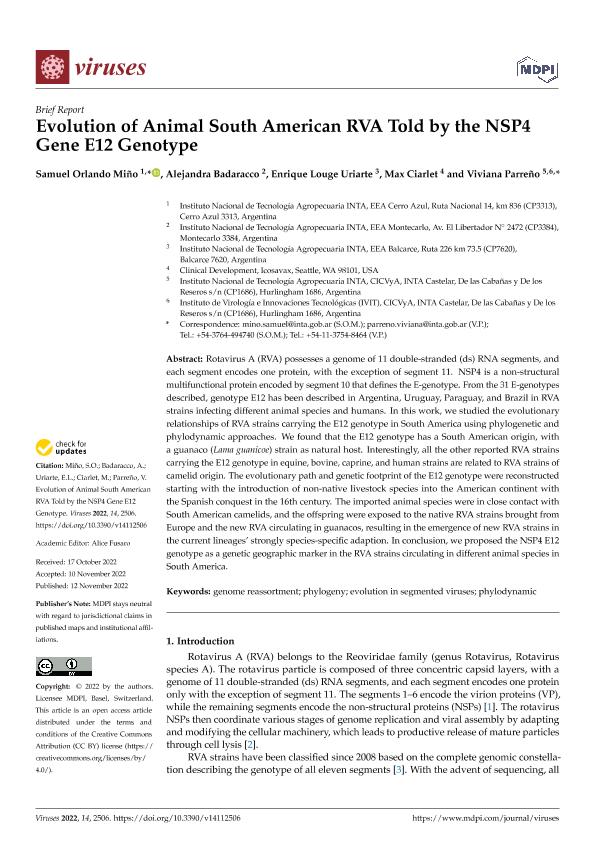Mostrar el registro sencillo del ítem
dc.contributor.author
Miño, Orlando Samuel

dc.contributor.author
Badaracco, Alejandra

dc.contributor.author
Louge Uriarte, Enrique Leopoldo

dc.contributor.author
Ciarlet, Max
dc.contributor.author
Parreño, Gladys Viviana

dc.date.available
2023-07-10T15:55:54Z
dc.date.issued
2022-11-12
dc.identifier.citation
Miño, Orlando Samuel; Badaracco, Alejandra; Louge Uriarte, Enrique Leopoldo; Ciarlet, Max; Parreño, Gladys Viviana; Evolution of Animal South American RVA Told by the NSP4 Gene E12 Genotype; MDPI; Viruses; 14; 11; 12-11-2022; 1-10
dc.identifier.issn
1999-4915
dc.identifier.uri
http://hdl.handle.net/11336/203017
dc.description.abstract
Rotavirus A (RVA) possesses a genome of 11 double-stranded (ds) RNA segments, and each segment encodes one protein, with the exception of segment 11. NSP4 is a non-structural multifunctional protein encoded by segment 10 that defines the E-genotype. From the 31 E-genotypes described, genotype E12 has been described in Argentina, Uruguay, Paraguay, and Brazil in RVA strains infecting different animal species and humans. In this work, we studied the evolutionary relationships of RVA strains carrying the E12 genotype in South America using phylogenetic and phylodynamic approaches. We found that the E12 genotype has a South American origin, with a guanaco (Lama guanicoe) strain as natural host. Interestingly, all the other reported RVA strains carrying the E12 genotype in equine, bovine, caprine, and human strains are related to RVA strains of camelid origin. The evolutionary path and genetic footprint of the E12 genotype were reconstructed starting with the introduction of non-native livestock species into the American continent with the Spanish conquest in the 16th century. The imported animal species were in close contact with South American camelids, and the offspring were exposed to the native RVA strains brought from Europe and the new RVA circulating in guanacos, resulting in the emergence of new RVA strains in the current lineages' strongly species-specific adaption. In conclusion, we proposed the NSP4 E12 genotype as a genetic geographic marker in the RVA strains circulating in different animal species in South America.
dc.format
application/pdf
dc.language.iso
eng
dc.publisher
MDPI
dc.rights
info:eu-repo/semantics/openAccess
dc.rights.uri
https://creativecommons.org/licenses/by/2.5/ar/
dc.subject
EVOLUTION IN SEGMENTED VIRUSES
dc.subject
GENOME REASSORTMENT
dc.subject
PHYLODYNAMIC
dc.subject
PHYLOGENY
dc.subject.classification
Virología

dc.subject.classification
Ciencias Biológicas

dc.subject.classification
CIENCIAS NATURALES Y EXACTAS

dc.title
Evolution of Animal South American RVA Told by the NSP4 Gene E12 Genotype
dc.type
info:eu-repo/semantics/article
dc.type
info:ar-repo/semantics/artículo
dc.type
info:eu-repo/semantics/publishedVersion
dc.date.updated
2023-07-08T00:24:22Z
dc.journal.volume
14
dc.journal.number
11
dc.journal.pagination
1-10
dc.journal.pais
Suiza

dc.description.fil
Fil: Miño, Orlando Samuel. Instituto Nacional de Tecnología Agropecuaria. Centro Regional Misiones. Estación Experimental Agropecuaria Cerro Azul; Argentina
dc.description.fil
Fil: Badaracco, Alejandra. Consejo Nacional de Investigaciones Científicas y Técnicas. Centro Científico Tecnológico Conicet - Nordeste; Argentina. Instituto Nacional de Tecnología Agropecuaria. Centro Regional Misiones. Estación Experimental Agropecuaria Montecarlo; Argentina
dc.description.fil
Fil: Louge Uriarte, Enrique Leopoldo. Instituto Nacional de Tecnología Agropecuaria. Centro Regional Buenos Aires Sur. Estación Experimental Agropecuaria Balcarce; Argentina. Consejo Nacional de Investigaciones Científicas y Técnicas; Argentina
dc.description.fil
Fil: Ciarlet, Max. No especifíca;
dc.description.fil
Fil: Parreño, Gladys Viviana. Instituto Nacional de Tecnología Agropecuaria. Centro de Investigación en Ciencias Veterinarias y Agronómicas. Instituto de Virología e Innovaciones Tecnológicas. - Consejo Nacional de Investigaciones Científicas y Técnicas. Oficina de Coordinación Administrativa Parque Centenario. Instituto de Virología e Innovaciones Tecnológicas; Argentina
dc.journal.title
Viruses
dc.relation.alternativeid
info:eu-repo/semantics/altIdentifier/url/https://www.mdpi.com/1999-4915/14/11/2506
dc.relation.alternativeid
info:eu-repo/semantics/altIdentifier/doi/https://dx.doi.org/10.3390/v14112506
Archivos asociados
